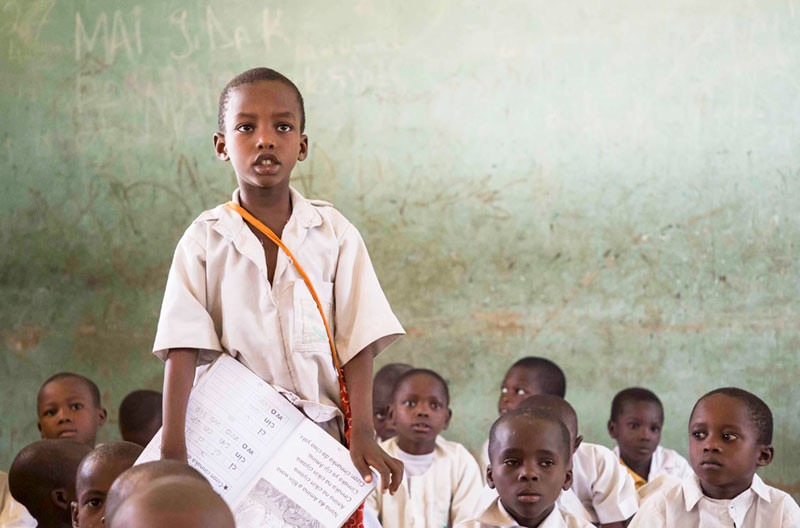Durante los últimos cinco años, El crecimiento global del número de niños en las aulas se ha estancado., según lo publicado recientemente Datos del Instituto de Estadística de la UNESCO.
Acerca de 263 Millones de niños (uno de cada cinco niños) adolescentes y jóvenes en todo el mundo no están escolarizados., la ONU. agencia informó. Desde 2012, El número de niños y jóvenes en edad escolar en las aulas de todo el mundo ha aumentado sólo aproximadamente 1 millón un año.
“Estas nuevas cifras muestran claramente el tamaño de la brecha que debe cerrarse para garantizar el acceso universal a la educación.,dijo la Directora General de la UNESCO, Audrey Azoulay, en un presione soltar. “Necesitamos enfoques mucho más integrales y específicos junto con más recursos para llegar a aquellos niños y jóvenes a quienes se les niega el derecho a la educación., con especial énfasis en las niñas y en mejorar la calidad de la educación para todos”.
África subsahariana sigue siendo la región con las tasas más altas de no escolarización en todos los grupos de edad, y representa más de la mitad (34 millón) del 63 millones de niños en edad primaria no escolarizados, según el informe.
Los países con las tasas más altas de no escolarización también tienden a estar entre los más pobres del mundo.. Los niveles de pobreza también están estrechamente relacionados con las disparidades de género en la educación..
El datos de la UNESCO destaca que si se sigue el mismo enfoque habitual no se logrará alcanzar la educación primaria y secundaria universal si 2030.

Garantizar la educación en medio de la crisis
Este llamado a adoptar nuevos enfoques es particularmente crítico dadas las crecientes tasas de personas desplazadas y refugiadas en todo el mundo., incluidos millones de niños y jóvenes en edad escolar, señala Eileen San. jorge, Director de Educación en conflicto en creativo, quién leyó el informe publicado.
Para estos niños y jóvenes no escolarizados, Las brechas en la educación pueden verse agravadas por el trauma del conflicto y el desplazamiento.. Los años sin asistir a la escuela pueden hacer retroceder a los alumnos en materia de alfabetización y habilidades para la vida; El trauma no curado puede afectar negativamente los resultados de sus vidas..
“Para mantener a los niños y jóvenes en las aulas, especialmente en entornos de conflicto y crisis, necesitamos enfoques cada vez más innovadores para minimizar la interrupción del aprendizaje.," dice San. jorge, agregando eso centros de aprendizaje comunitarios no formales puede ayudar a brindar educación básica a los estudiantes desplazados cuando las escuelas formales no son una opción.
Independientemente del foro para la educación, un sentido de normalidad y seguridad es particularmente crítico para el desarrollo de estos estudiantes vulnerables., ella agrega.
“Es esencial que las escuelas creen un ambiente seguro para que los estudiantes reciban una educación de calidad y se recuperen a través del apoyo psicosocial y el aprendizaje socioemocional.," ella dice.
En países afectados por conflictos como Afganistán y Nigeria, Creative está implementando múltiples proyectos educativos que integran actividades de aprendizaje socioemocional en su plan de estudios..
“Al proporcionar Aprendizaje socioemocional apoyo en el aula, Educadores en entornos complejos como Nigeria y Afganistán., Puede crear un ambiente de aprendizaje poderoso que fomente la curación., apoyo, Motivación y, en última instancia, éxito de los niños y jóvenes vulnerables.," dice San. jorge. "Sin embargo, Para lograrlo también debemos prestar atención al bienestar de los docentes., permitiéndoles nutrir eficazmente a los niños y jóvenes en sus aulas”.
Empoderar a las niñas a través de la educación
La UNESCO también concluye que en todo el mundo, Las niñas siguen enfrentando barreras para recibir educación..
El Cifras de la UNESCO demuestran que en el África subsahariana, Las niñas de todos los grupos en edad escolar tienen más probabilidades de ser excluidas de la educación que los niños.. por cada 100 niños de edad primaria fuera de la escuela, hay 123 A las niñas se les niega el derecho a la educación..
Actitudes tradicionales y creencias culturales., pobreza, matrimonio temprano y embarazo y VIolence contra mujeres y niñas, se encuentran entre las muchas barreras que impiden que las niñas accedan a una educación de calidad.
Karen Tietjen, Director de Sistemas de instrucción y gobernanza en creativo, apunta a la USAID Leer para tener éxito proyecto “toda la escuela, maestro completo, El enfoque “integral del alumno” como ejemplo de una forma eficaz de contrarrestar el abandono escolar, especialmente en el caso de las niñas vulnerables..
El “niño completo” de Creative, maestro completo, toda la escuela, El enfoque de "sistema completo" aborda factores críticos de oferta y demanda que afectan el aprendizaje., enseñanza, gestión, Participación de los padres y capacidad de respuesta a las necesidades de los niños..
“Cuando las niñas dejan de ir a la escuela por responsabilidades domésticas, embarazo temprano u otras barreras, están cerrando la puerta a un futuro mejor," ella dice. “El proyecto Leer para el Éxito en Zambia proporcionó herramientas psicosociales y apoyo de asesoramiento necesario para ayudar a los estudiantes a tener éxito en la escuela y en la vida”.
Tietjen dice que el proyecto educativo capacitó a maestros de orientación y asesoramiento que también movilizaron un grupo de jóvenes aliados enérgicos y eficaces para ayudar a apoyar a los estudiantes vulnerables..
Llamado Agentes de cambio, Estos grupos de adolescentes trabajaron codo con codo con profesores de orientación y asesoramiento para transmitir mensajes importantes a sus compañeros de clase sobre la permanencia en la escuela., practicar comportamientos saludables y tomar decisiones inteligentes.
“Con un sistema de apoyo, Fuimos testigos de cómo niñas zambianas vulnerables permanecían en la escuela a pesar de lidiar con problemas sociales., Desafíos económicos y psicológicos fuera del aula.,"dice Tietjen.
“Cuando las niñas tienen la oportunidad de acceder a una educación de calidad, Están empoderados para adquirir los conocimientos y habilidades necesarios para ayudar a romper el ciclo de la pobreza por sí mismos., sus familias y comunidades," ella dice.



